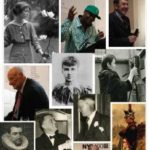.. as reported in
By Sam Roberts
During the last Gilded Age, in the 1890s, the number of living New Yorkers over whom Mrs. William Astor presided as the doyenne of discriminating society was famously quantified as “the Four Hundred.”
To introduce the celebration of Henry Hudson’s exploration this year, the Museum of the City of New York has compiled its own, more democratic list of 400 movers and shakers who have made a difference in the 400 years since Hudson arrived in 1609.
The latest list, “The New York City 400,” to be unveiled on Wednesday, is peppered with a few surnames that would have been familiar on the original: two Astors (the first John Jacob and Brooke), four Rockefellers (David, Nelson, John D. and John D. Jr.) and three Roosevelts (Theodore, Franklin and Eleanor).
But the museum’s curators and other experts have diluted the blue blood by compiling a list that, given its more eclectic and historically encompassing criteria, is more diverse (and also heavier on arts personalities). Taken together, these 400 are people whom New Yorkers might be more likely to encounter on the subway than in Mrs. Astor’s ballroom (that’s Caroline Astor – a grandmother of Brooke Astor’s husband Vincent). Among them are Fred Lebow, who organized the New York City Marathon; Meyer Lansky, the gangster; Larry Kramer, the playwright and a founder of the group Act Up, which led the fight for AIDS research; Frank Serpico, the whistle-blower cop; Jerry Seinfeld, the comedian; Douglas Durst, the real estate developer; Ian Schrager, the hotelier and co-
founder of Studio 54; Kitty Genovese, whose screams as she was being stabbed to death were ignored by at least 38 Queens neighbors in 1964; Sean Combs, the hip-hop mogul and rapper; Edward W. Said, the Columbia professor and advocate for Palestinian rights; Jean-Michel Basquiat, the artist who began with graffiti; Elisha G. Otis, who perfected the elevator; and “Typhoid Mary” Mallon.
“To celebrate the historic anniversary of the city’s founding, the museum decided to humanize the city’s history,” said Susan Henshaw Jones, the museum’s president. The list is being released in conjunction with the publication of the museum’s book, “New York 400: A Visual History of America’s Greatest City.” The full list can be found at nytimes.com/nyregion.
Half the fun of lists like these is arguing about who is left off.
“New York City 400 is definitely not a definitive list,” Ms. Jones said. “It is intended to be fun and provocative, stimulating New Yorkers and those who love New York City everywhere to think about others they believe should be on our next list of New York City 400.”
Forty-three of the latest 400 are still alive. They include Woody Allen, Louis Auchincloss (the author and the museum’s chairman emeritus), Herman Badillo, Mel Brooks, Pete Hamill, Rupert Murdoch, Ralph Lauren, Maya Lin, Al Sharpton, Russell Simmons, Sonia Sotomayor, Donald Trump and Tom Wolfe.
Among the recent mayors, Edward I. Koch, Rudolph W. Giuliani and Michael R. Bloomberg made the lineup, but David N. Dinkins and Abraham D. Beame did not. Albert Shanker, the former teachers’ union president (immortalized by Woody Allen in “Sleeper”) is listed, but what about Victor Gotbaum?
Or Branch Rickey, who hired Jackie Robinson; Jack Maple, who developed the CompStat crime control system; Townsend Harris, who founded City College; Al Primo, who brought the “Eyewitness News” format to local television; Adriaen Van der Donck, whose lobbying produced the city’s first municipal charter in 1653; and Wally Pipp, whose “headache” in 1925 supposedly led to his replacement at first base, for the next 2,130 games, by Lou Gehrig?
The original list of 400 was attributed to Ward McAllister, the late-19th-century arbiter of social status. “If you go outside that number,” he warned, “you strike people who are either not at ease in a ballroom or else make other people not at ease.”
A century later, McAllister has been elevated to a unique position. He is the only person on the original Four Hundred to also make the museum’s list.
